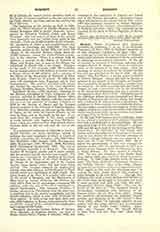

Burnett, PETER HARDEMAN, first American Governor of California, U.S.A., b. in Nashville, Tennessee, November 15, 1807, of Virginian ancestry; d. at San Francisco, California, May 16, 1895. At an early age he was taken by his father to Missouri, where amid primitive conditions of life he succeeded in obtaining an elementary education. At the age of nineteen he returned to Tennessee, and soon after married Harriet W. Rogers, to whom he attributed much of the success of his later career. After his marriage he started in business for himself, studied law and was admitted to the bar in 1839. He also edited “The Far West”, a weekly paper published at Liberty, Missouri. About this time he became a member of the Church of the Disciples, or Campbellites, founded by Alexander Campbell, a seceder from the Baptists. In 1843, removing with his family to Oregon, he took a prominent part in the formation of the territorial government and was a member of the legislature from 1844 to 1848. During this period the published debate between Campbell and Bishop Purcell of Cincinnati fell into his hands, and though after reading it he still remained a Protestant, his confidence in Protestantism was considerably shaken. He then began a systematic investigation of the true religion, became convinced of the truth of the Catholic claims, and in June, 1846, was received into the Church at Oregon City by Father De Vos.
In the year 1848 Burnett went to California, where he was elected a member of the Legislative Assembly and took a leading part in its proceedings. He was appointed judge of the superior tribunal in August, 1849 and did good work in the framing of the State Constitution. In September he was chosen chief justice, and on the thirteenth of November of the same year he was elected the first American Governor of California, though California was not admitted as a State into the Union till September, 1850. He resigned the governorship in 1851 and resumed the practice of law until his appointment in 1857 as a Justice of the Supreme Court of California by Gov. J. Neely Johnson. His term expired in October, 1858. He was also President of the Pacific Bank from 1863 to 1880, after which he retired from active business. In 1860 Judge Burnett wrote his famous book “The Path which led a Protestant Lawyer to the Catholic Church” (New York, 1860), wherein he bases his conversion on clear-cut logical principles. With regard to this work Dr. Brownson says “In writing his book, Judge Burnett has rendered a noble homage to his new faith…Through him, California has made a more glorious contribution to the Union than all the gold of her mines, for truth is more precious than gold, yea, than fine gold” (Brownson‘s Review, April, 1860). This was followed by his work on “The American Theory of Government, Considered with Reference to the Present Crisis” (2d ed., New York, 1861). During the period of his retirement he published “Recollections and Opinions of an Old Pioneer” (New York, 1860), which “is especially valuable in connection with the early political and constitutional history of the Pacific coast” (Nation, XXX, 389), and “Reasons Why We Should Believe in God, Love God and Obey God” (New York, 1884).
EDWARD P. SPILLANE

